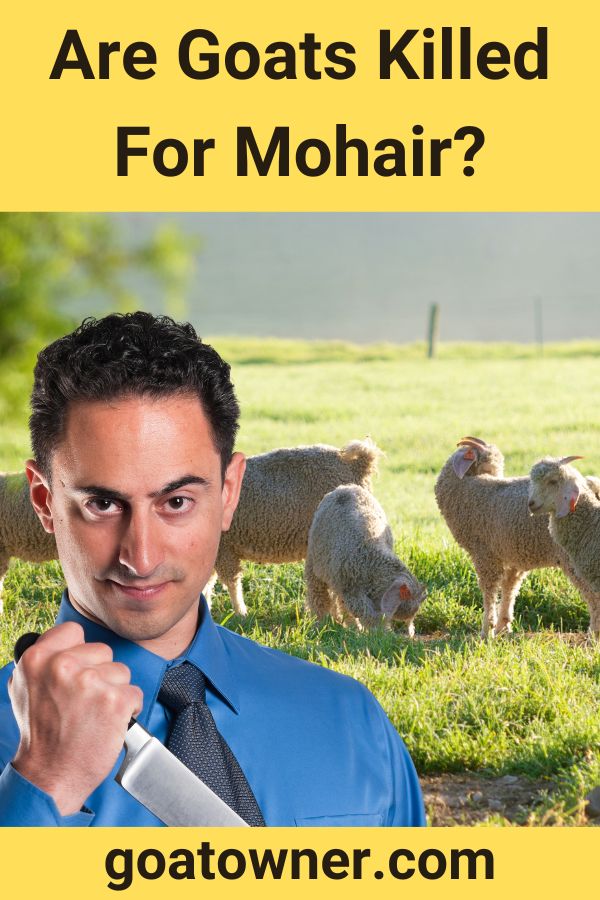Mohair is one of the biggest goat commodities that is traded in the world.
Of course, it doesn’t touch the figures achieved by selling milk or meat, but mohair is nonetheless a huge industry.
We are all concerned about goat welfare, though, so for those of us who don’t know, it’s natural to worry about how mohair is obtained—are goats killed for it?
You do not have to kill a goat to harvest its mohair, so they usually are not killed for it. They are not hunted for it, either, as mohair is only found on the Angora goat, which are entirely domestic and not wild. But mohair goats may be killed once they are no longer valuable.
So, no, goats are not killed in order that their mohair be harvested.
However, they are killed when they will not produce any more mohair.
It’s important to clear up any confusion that wild Angora goats are somehow hunted for their mohair.
The breed is so valuable that there are just no feral populations.
Let’s find out more.
Do goats get killed for mohair?
No, they do not, generally speaking.
Shearing an Angora goat is much like shearing a sheep, although goats tend to be less happy about being handled in this way.
In any case, you can shear an Angora sheep and then simply release it to regrow its coat again.
They don’t have to be killed in order to shear the coat off.
They are also not killed in the sense that they are hunted for their mohair.
Angora goats were bred centuries ago to develop these rich coats, so the fibers could be sold around the world.
Angora goats are not a natural occurrence, and given their value, certainly not something you would find in the wild.
They aren’t hunted for it, then.
The controversy surrounds the overall treatment of goats in the industry.
Angora goats generally have a lifespan of around 10 years, when they are allowed to live out their days.
In the mohair industry, though, they generally are killed as soon as they are not profitable anymore—this is typically around 6 years old.
So, they are killed in the sense that they are culled when no longer profitable.
The other issue is one of cruelty—so is mohair cruel?
Is mohair cruel?
By many accounts, yes, mohair production is extremely cruel.
Goats are handled roughly and without care, often mutilated, whether intentionally or not, and are eventually slaughtered.
Often, mohair workers are paid by volume, rather than hours worked.
This leads to careless and inhumane practices, which cause the goats unnecessary suffering.
Many clothing brands around the world have banned the use of mohair due to the problems of the industry.
This said, it need not necessarily be cruel. Harvesting mohair from goats on a small scale can be a perfectly ethical practice.
The problem is, though, that due to the expense of the fiber, there are not very many such operations.
Most mohair farms are large, and lead to unethical practices.
Mohair is often simply considered a matter of status, too.
While processed mohair has a soft, silky texture, it is not really much better than many synthetic fibers we now have.
Owning mohair is a statement that you have the money to pay for it.
So, while it need not be inherently cruel, the mohair industry as it exists today is certainly blighted by endemic cruelty.
Is mohair Angora wool?
Yes, it is. Mohair is exclusively the fibers from the Angora goat breed.
The breed is believed to have originated in Tibet, and finally made its way to Turkey by the 16th Century.
It spread globally to its current status from there.
Ankara was once the only place in the world where Angora goats were produced, and thus they had the monopoly on mohair.
Today, though, Angora goats are bred throughout the world, and their mohair sold in many diverse places.
How valuable is mohair?
It depends where you are in the world, and how much it is in demand.
There are many mohair producers here in the United States, and they suggest a good ballpark figure is around $10 per pound for mohair.
Compared with sheep wool, which sells for around $0.40 per pound, you can see how incredibly valuable mohair can be.
The industry is worth a huge amount of money and will grow more if they can work past the unethical practices.
Is mohair eco-friendly?
Raising livestock always leaves a pretty considerable carbon footprint.
Again, though, it depends on the scale of the operation we are talking about.
Small-scale mohair farms can certainly be environmentally conscious and even carbon neutral.
In general, though, large-scale mohair operations are not eco-friendly and leave a big environmental mark.
Growing, transporting, and processing their feed, the amount of water that is needed to sustain them, plus the carbon footprint of shipping this fiber all over the world.
This is another issue that will need to be worked out.
Mohair, as an industry, is under a great deal of scrutiny at the moment, then.
Despite the fact that goats are not hunted for it, and the animal does not need to be killed to harvest the mohair, there are many cruel practices associated with the industry.
Goats are treated poorly and harshly and are discarded as soon as they are not profitable.
But they are not, in the simplest sense, killed for their mohair.

